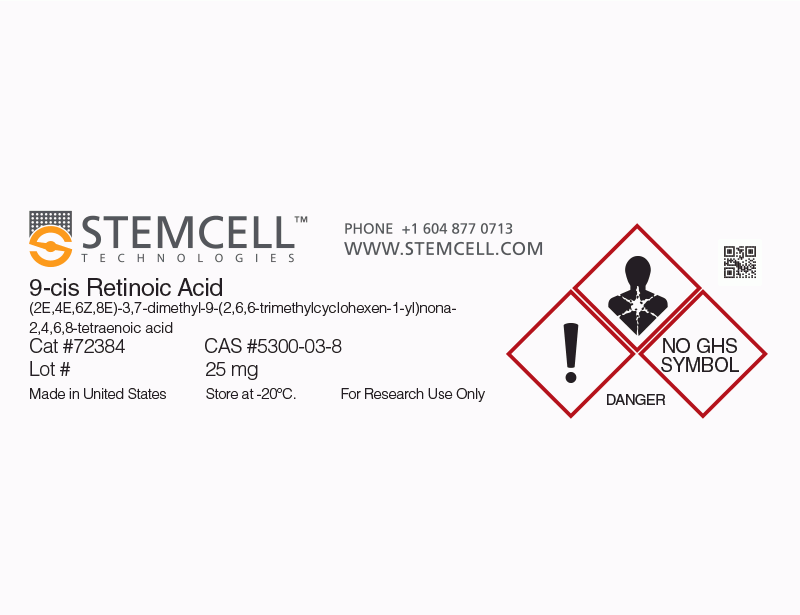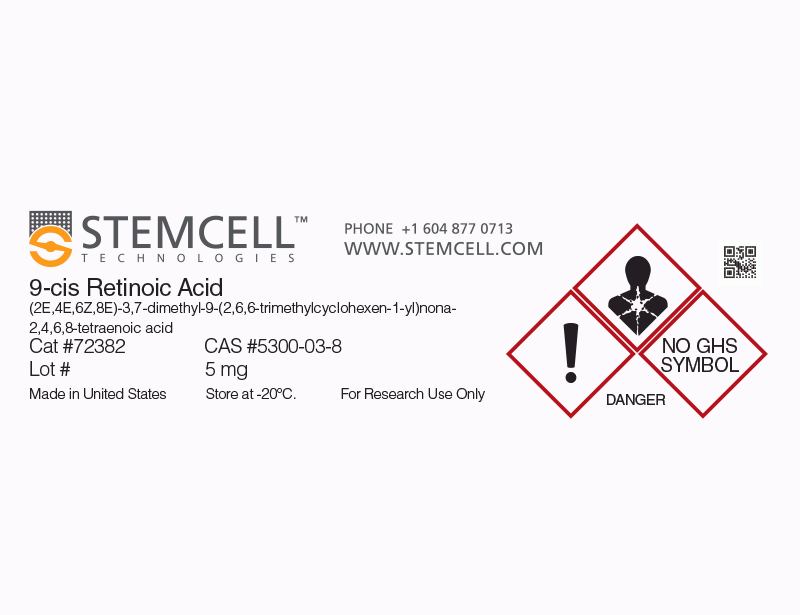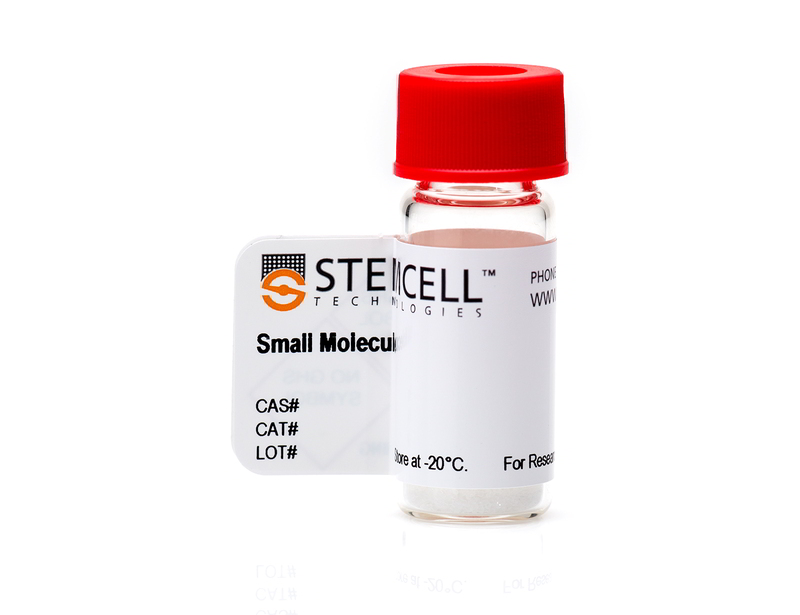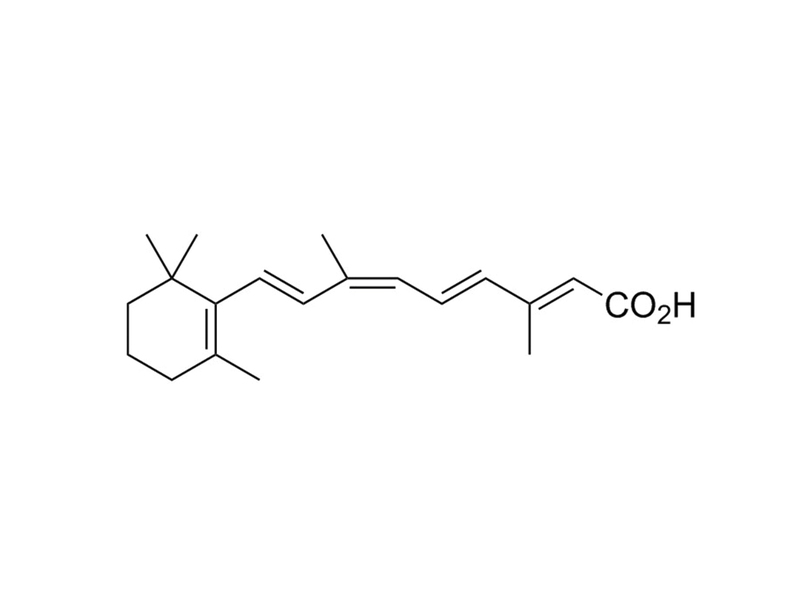9-cis Retinoic Acid
Retinoid pathway activator; Activates retinoic acid receptor (RAR) and retinoid X receptor (RXR)
概要
9-cis-Retinoic acid activates all isoforms of the retinoic acid receptor (RAR) (Ki = 0.5-27 nM) as well as retinoid X receptor (RXR) isoforms (Ki = 3.8-12 nM) (Umemiya et al.; Wong et al.). The ability of RAR to heterodimerize with RXR, and the latter to heterodimerize with other partners allows 9-cis-retinoic acid to evoke a wide range of effects (Dawson et al.; Kane).
DIFFERENTIATION
· Increases the number of neurons derived from rat neural stem cell cultures (Laeng et al.).
· Promotes oligodendrocyte precursor cell differentiation and myelination in cultured cells and mouse cerebellar slices (Huang et al.).
· Induces formation of pancreatic ducts, but not acini, in embryonic mouse pancreas grown in collagen gel (Kadison et al.; Kobayashi et al.).
· Enhances BMP9-induced osteogenic differentiation of mesenchymal progenitor cells, in vitro and in vivo (Zhang et al.).
· Induces myogenic differentiation of C2C12 myoblast progenitor cells (Zhu et al.).
CANCER RESEARCH
· Inhibits proliferation of Epstein-Barr virus-infected lymphoblastoid cell lines (Pomponi et al.).
· Inhibits growth of cultured human gastric cancer cells (Naka et al.).
· Inhibits spontaneous proliferation and CD40-induced growth in primary mantle cell lymphoma cells (Guidoboni et al.).
DIFFERENTIATION
· Increases the number of neurons derived from rat neural stem cell cultures (Laeng et al.).
· Promotes oligodendrocyte precursor cell differentiation and myelination in cultured cells and mouse cerebellar slices (Huang et al.).
· Induces formation of pancreatic ducts, but not acini, in embryonic mouse pancreas grown in collagen gel (Kadison et al.; Kobayashi et al.).
· Enhances BMP9-induced osteogenic differentiation of mesenchymal progenitor cells, in vitro and in vivo (Zhang et al.).
· Induces myogenic differentiation of C2C12 myoblast progenitor cells (Zhu et al.).
CANCER RESEARCH
· Inhibits proliferation of Epstein-Barr virus-infected lymphoblastoid cell lines (Pomponi et al.).
· Inhibits growth of cultured human gastric cancer cells (Naka et al.).
· Inhibits spontaneous proliferation and CD40-induced growth in primary mantle cell lymphoma cells (Guidoboni et al.).
Alternative Names
9-cis-retinoic acid; Aliretinoin; NSC 659772; Panretin
Cell Type
Cancer Cells and Cell Lines, Leukemia/Lymphoma Cells, Mesenchymal Stem and Progenitor Cells, Myogenic Stem and Progenitor Cells, Neural Stem and Progenitor Cells, Osteoblasts, Pancreatic Cells
Species
Human, Mouse, Rat, Non-Human Primate, Other
Application
Differentiation
Area of Interest
Cancer Research, Neuroscience, Stem Cell Biology
CAS Number
5300-03-8
Chemical Formula
C₂₀H₂₈O₂
Molecular Weight
300.4 g/mol
Purity
≥ 95%
Pathway
Retinoid
Target
RAR, RXR
技术资料
| Document Type | 产品名称 | Catalog # | Lot # | 语言 |
|---|---|---|---|---|
| Product Information Sheet | 9-cis Retinoic Acid | 72382, 72384 | All | English |
| Safety Data Sheet | 9-cis Retinoic Acid | 72382, 72384 | All | English |
数据及文献
Publications (12)
Biochimica et biophysica acta 2012 JAN
The retinoid X receptors and their ligands.
Abstract
Abstract
This chapter presents an overview of the current status of studies on the structural and molecular biology of the retinoid X receptor subtypes α, β, and γ (RXRs, NR2B1-3), their nuclear and cytoplasmic functions, post-transcriptional processing, and recently reported ligands. Points of interest are the different changes in the ligand-binding pocket induced by variously shaped agonists, the communication of the ligand-bound pocket with the coactivator binding surface and the heterodimerization interface, and recently identified ligands that are natural products, those that function as environmental toxins or drugs that had been originally designed to interact with other targets, as well as those that were deliberately designed as RXR-selective transcriptional agonists, synergists, or antagonists. Of these synthetic ligands, the general trend in design appears to be away from fully aromatic rigid structures to those containing partial elements of the flexible tetraene side chain of 9-cis-retinoic acid. This article is part of a Special Issue entitled Advances in High Density Lipoprotein Formation and Metabolism: A Tribute to John F. Oram (1945-2010).
Biochimica et biophysica acta 2012 JAN
Analysis, occurrence, and function of 9-cis-retinoic acid.
Abstract
Abstract
Metabolic conversion of vitamin A (retinol) into retinoic acid (RA) controls numerous physiological processes. 9-cis-retinoic acid (9cRA), an active metabolite of vitamin A, is a high affinity ligand for retinoid X receptor (RXR) and also activates retinoic acid receptor (RAR). Despite the identification of candidate enzymes that produce 9cRA and the importance of RXRs as established by knockout experiments, in vivo detection of 9cRA in tissue was elusive until recently when 9cRA was identified as an endogenous pancreas retinoid by validated liquid chromatography-tandem mass spectrometry (LC-MS/MS) methodology. This review will discuss the current status of the analysis, occurrence, and function of 9cRA. Understanding both the nuclear receptor-mediated and non-genomic mechanisms of 9cRA will aid in the elucidation of disease physiology and possibly lead to the development of new retinoid-based therapeutics. This article is part of a Special Issue entitled Retinoid and Lipid Metabolism.
Nature neuroscience 2011 JAN
Retinoid X receptor gamma signaling accelerates CNS remyelination.
Abstract
Abstract
The molecular basis of CNS myelin regeneration (remyelination) is poorly understood. We generated a comprehensive transcriptional profile of the separate stages of spontaneous remyelination that follow focal demyelination in the rat CNS and found that transcripts that encode the retinoid acid receptor RXR-γ were differentially expressed during remyelination. Cells of the oligodendrocyte lineage expressed RXR-γ in rat tissues that were undergoing remyelination and in active and remyelinated multiple sclerosis lesions. Knockdown of RXR-γ by RNA interference or RXR-specific antagonists severely inhibited oligodendrocyte differentiation in culture. In mice that lacked RXR-γ, adult oligodendrocyte precursor cells efficiently repopulated lesions after demyelination, but showed delayed differentiation into mature oligodendrocytes. Administration of the RXR agonist 9-cis-retinoic acid to demyelinated cerebellar slice cultures and to aged rats after demyelination caused an increase in remyelinated axons. Our results indicate that RXR-γ is a positive regulator of endogenous oligodendrocyte precursor cell differentiation and remyelination and might be a pharmacological target for regenerative therapy in the CNS.
PloS one 2010 JUL
Retinoic acids potentiate BMP9-induced osteogenic differentiation of mesenchymal progenitor cells.
Abstract
Abstract
BACKGROUND As one of the least studied bone morphogenetic proteins (BMPs), BMP9 is one of the most osteogenic BMPs. Retinoic acid (RA) signaling is known to play an important role in development, differentiation and bone metabolism. In this study, we investigate the effect of RA signaling on BMP9-induced osteogenic differentiation of mesenchymal progenitor cells (MPCs). METHODOLOGY/PRINCIPAL FINDINGS Both primary MPCs and MPC line are used for BMP9 and RA stimulation. Recombinant adenoviruses are used to deliver BMP9, RARalpha and RXRalpha into MPCs. The in vitro osteogenic differentiation is monitored by determining the early and late osteogenic markers and matrix mineralization. Mouse perinatal limb explants and in vivo MPC implantation experiments are carried out to assess bone formation. We find that both 9CRA and ATRA effectively induce early osteogenic marker, such as alkaline phosphatase (ALP), and late osteogenic markers, such as osteopontin (OPN) and osteocalcin (OC). BMP9-induced osteogenic differentiation and mineralization is synergistically enhanced by 9CRA and ATRA in vitro. 9CRA and ATRA are shown to induce BMP9 expression and activate BMPR Smad-mediated transcription activity. Using mouse perinatal limb explants, we find that BMP9 and RAs act together to promote the expansion of hypertrophic chondrocyte zone at growth plate. Progenitor cell implantation studies reveal that co-expression of BMP9 and RXRalpha or RARalpha significantly increases trabecular bone and osteoid matrix formation. CONCLUSION/SIGNIFICANCE Our results strongly suggest that retinoid signaling may synergize with BMP9 activity in promoting osteogenic differentiation of MPCs. This knowledge should expand our understanding about how BMP9 cross-talks with other signaling pathways. Furthermore, a combination of BMP9 and retinoic acid (or its agonists) may be explored as effective bone regeneration therapeutics to treat large segmental bony defects, non-union fracture, and/or osteoporotic fracture.
Differentiation 2009 NOV
Activation of RXR and RAR signaling promotes myogenic differentiation of myoblastic C2C12 cells.
Abstract
Abstract
Differentiation of embryonic and adult myogenic progenitors undergoes a complex series of cell rearrangements and specification events which are controlled by distinct gene regulatory networks. Delineation of the molecular mechanisms that regulate skeletal muscle specification and formation should be important for understanding congenital myopathies and muscular degenerative diseases. Retinoic acid (RA) signaling plays an important role in development. However, the role of RA signaling in adult myogenic progenitors is poorly understood. Here, we investigate the role of RA signaling in regulating myogenic differentiation of myoblastic progenitor cells. Using the mouse myoblast progenitor C2C12 line as a model, we have found that the endogenous expression of most RAR and RXR isotypes is readily detected. While the nuclear receptor co-repressors are highly expressed, two of the three nuclear receptor co-activators and the enzymes involved in RA synthesis are expressed at low level or undetectable, suggesting that the RA signaling pathway may be repressed in myogenic progenitors. Using the alpha-myosin heavy chain promoter-driven reporter (MyHC-GLuc), we have demonstrated that either ATRA or 9CRA is able to effectively induce myogenic differentiation, which can be synergistically enhanced when both ATRA and 9CRA are used. Upon ATRA and 9CRA treatment of C2C12 cells the expression of late myogenic markers significantly increases. We have further shown that adenovirus-mediated exogenous expression of RARalpha and/or RXRalpha is able to effectively induce myogenic differentiation in a ligand-independent fashion. Morphologically, ATRA- and 9CRA-treated C2C12 cells exhibit elongated cell body and become multi-nucleated myoblasts, and even form myoblast fusion. Ultrastructural analysis under transmission electron microscope reveals that RA-treated myogenic progenitor cells exhibit an abundant presence of muscle fibers. Therefore, our results strongly suggest that RA signaling may play an important role in regulating myogenic differentiation.
Cancer research 2005 JAN
Retinoic acid inhibits the proliferative response induced by CD40 activation and interleukin-4 in mantle cell lymphoma.
Abstract
Abstract
Mantle cell lymphoma (MCL) is an aggressive B-cell non-Hodgkin's lymphoma with poor response to therapy and unfavorable prognosis. Here, we show that retinoic acid (RA) isomers significantly inhibit the proliferation of both primary MCL cultures (n = 7) and established cell lines (Granta 519 and SP-53) as shown by [(3)H]thymidine uptake and carboxyfluorescein diacetate succinimidyl ester labeling coupled with cyclin D1 staining. RA induces cell accumulation in G(0)-G(1) together with a marked up-regulation of p27(Kip1) by inhibiting ubiquitination and proteasome-dependent degradation of the protein. The p21(Cip1) inhibitor was also up-regulated by RA in Granta 519 cells, whereas the expression of cyclin D1 is unaffected. Most of RA-induced p27(Kip1) was bound to cyclin D1/cyclin-dependent kinase 4 complexes, probably contributing to the decreased cyclin-dependent kinase 4 kinase activity and pRb hypophosphorylation observed in RA-treated cells. Experiments with receptor-selective ligands indicate that RA receptor alpha cooperates with retinoid X receptors in mediating RA-dependent MCL cell growth inhibition. Notably, RA isomers, and particularly 9-cis-RA, also inhibited the growth-promoting effect induced in primary MCL cells by CD40 activation alone or in combination with interleukin-4. Immunohistochemical analysis showed that significant numbers of CD40L-expressing lymphoid cells are present in lymph node biopsies of MCL patients. These results therefore further strengthen the possibility that triggering of CD40 by infiltrating CD40L+ cells may continuously promote the growth of MCL cells in vivo. On these grounds, our findings that RA inhibits basal MCL proliferation as well as MCL growth-promoting effects exerted by microenvironmental factors make these compounds highly attractive in terms of potential clinical efficacy in this setting.




